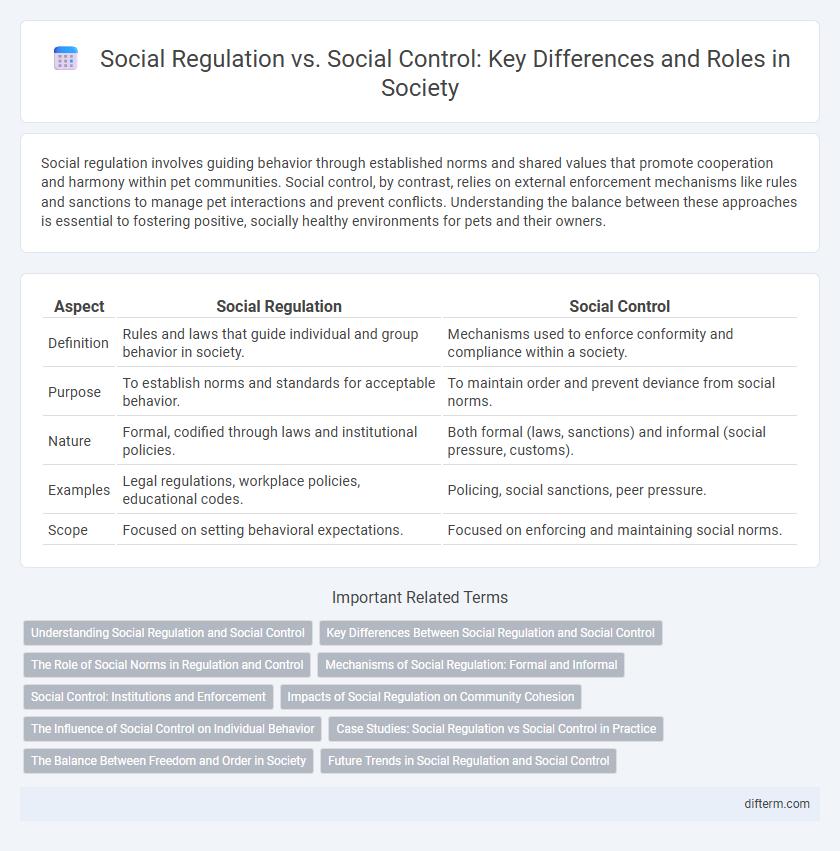Social regulation involves guiding behavior through established norms and shared values that promote cooperation and harmony within pet communities. Social control, by contrast, relies on external enforcement mechanisms like rules and sanctions to manage pet interactions and prevent conflicts. Understanding the balance between these approaches is essential to fostering positive, socially healthy environments for pets and their owners.
Table of Comparison
| Aspect | Social Regulation | Social Control |
|---|---|---|
| Definition | Rules and laws that guide individual and group behavior in society. | Mechanisms used to enforce conformity and compliance within a society. |
| Purpose | To establish norms and standards for acceptable behavior. | To maintain order and prevent deviance from social norms. |
| Nature | Formal, codified through laws and institutional policies. | Both formal (laws, sanctions) and informal (social pressure, customs). |
| Examples | Legal regulations, workplace policies, educational codes. | Policing, social sanctions, peer pressure. |
| Scope | Focused on setting behavioral expectations. | Focused on enforcing and maintaining social norms. |
Understanding Social Regulation and Social Control
Social regulation entails formal rules and laws established by institutions to guide behavior and maintain order within societies. Social control encompasses both formal mechanisms like laws and informal mechanisms such as social norms, customs, and peer pressure that influence individuals' behavior. Understanding the differences and interplay between social regulation and social control is essential for grasping how societies maintain stability and address deviance.
Key Differences Between Social Regulation and Social Control
Social regulation involves formal rules and laws established by institutions to manage behavior within society, while social control encompasses both formal mechanisms and informal social norms that influence individual actions. Social regulation is typically enforced through legal systems and government agencies, whereas social control relies on cultural norms, socialization, and peer pressure. The key difference lies in social regulation's structured, codified guidelines compared to social control's broader, often informal social influence mechanisms.
The Role of Social Norms in Regulation and Control
Social norms play a critical role in social regulation and social control by guiding individual behavior to align with community expectations. These unwritten rules promote conformity and cooperation, reducing the need for formal sanctions or legal enforcement. Through internalization, social norms enable societies to maintain order and social cohesion effectively.
Mechanisms of Social Regulation: Formal and Informal
Mechanisms of social regulation include formal rules enforced by institutions such as laws and policies, which provide clear guidelines and penalties for behavior. Informal mechanisms rely on unwritten social norms, customs, and peer pressure that influence individuals through approval or disapproval within the community. Together, formal and informal social regulation maintain order by shaping behavior and ensuring conformity to societal expectations.
Social Control: Institutions and Enforcement
Social control operates through institutions such as the legal system, law enforcement agencies, and educational bodies to maintain societal norms and order. These institutions enforce rules and sanctions designed to deter deviant behavior and promote conformity within communities. Effective social control relies on consistent application of laws, regulations, and social expectations to uphold public safety and social cohesion.
Impacts of Social Regulation on Community Cohesion
Social regulation fosters community cohesion by establishing shared norms and expectations that guide individual behavior, reducing conflicts and promoting social harmony. It creates structured frameworks for cooperation, enhancing trust and collective identity among members of the community. By formalizing roles and responsibilities, social regulation supports stability and integration within diverse social groups.
The Influence of Social Control on Individual Behavior
Social control mechanisms, such as laws, norms, and sanctions, shape individual behavior by establishing boundaries of acceptable conduct and encouraging conformity within a community. Internalized social control, through values and beliefs, guides personal decision-making and self-discipline, reducing deviant actions. Empirical studies show that stronger social control correlates with lower rates of antisocial behavior and increased social cohesion.
Case Studies: Social Regulation vs Social Control in Practice
Case studies comparing social regulation and social control reveal distinct approaches to managing community behavior and compliance, with social regulation involving formal rules and policies, such as environmental laws, while social control emphasizes informal mechanisms like social norms and peer pressure. For example, urban planning regulations enforce building codes to regulate safety standards, whereas neighborhood watch programs exemplify social control by encouraging collective vigilance to deter crime. These practical examples demonstrate how both strategies operate simultaneously to maintain social order and promote public welfare.
The Balance Between Freedom and Order in Society
Social regulation enforces formal rules and laws to maintain order, while social control includes informal mechanisms like norms and customs that influence behavior. Achieving the balance between freedom and order requires ensuring regulations protect individual rights without stifling personal autonomy. Effective social systems integrate both approaches to foster a stable yet flexible society.
Future Trends in Social Regulation and Social Control
Future trends in social regulation and social control emphasize the integration of advanced technologies such as artificial intelligence and big data analytics to enhance monitoring and enforcement mechanisms. Increasing reliance on digital platforms facilitates real-time behavior tracking, enabling adaptive regulatory frameworks that respond swiftly to societal changes. Ethical considerations and privacy concerns drive the development of transparent policies balancing effective social control with individuals' rights and freedoms.
social regulation vs social control Infographic

 difterm.com
difterm.com